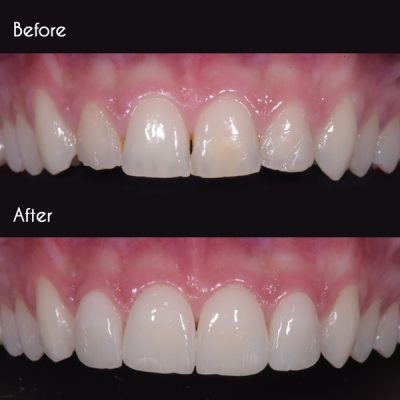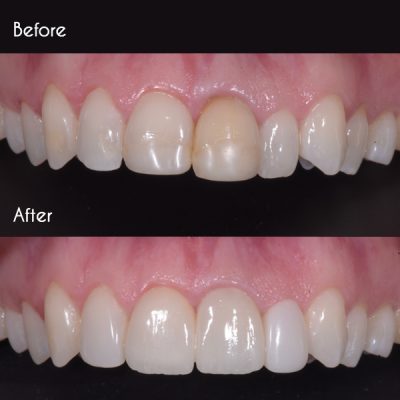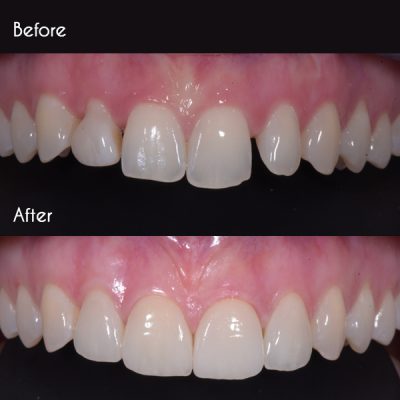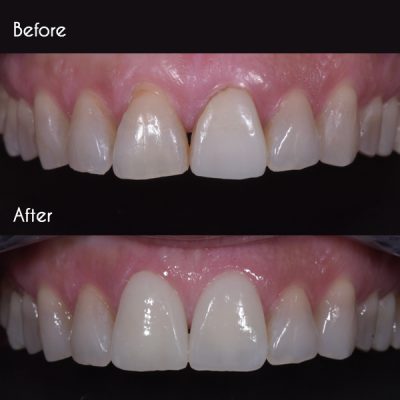Dental veneers are thin customized ceramic laminates that are applied to the outer surface of the tooth with a minimally invasive technique that involves preparing the enamel with a slight filing, or in cases where it can be done with the no-prep technique, without affecting the dental enamel.
Considered a highly effective cosmetic solution, veneers are used to restore shape and natural color to damaged, stained, or traumatized teeth, such as those with an unrecoverable dental fracture, or chipping caused by bruxism, bad habits such as biting hard objects like pen caps or nails.
Veneers allow the correct volume and shape of the teeth to be restored, and can refine the spaces left after orthodontic treatment, giving the smile a natural harmony.
When possible, composite resin veneers may also be considered. These have the same indications as porcelain veneers and are made directly in the dental chair without the intervention of a dental laboratory.
A dental checkup will help determine if veneers are the correct solution for the specific case because teeth can present different problems and veneers are not always the best treatment option.
There are no contraindications for their use because they can be applied both in the upper and lower arches, usually on incisors and canines, and in some cases even on premolars. Molars are usually excluded because the higher chewing load suggests that partial restorations are preferable as they provide a more adequate biomechanical response.
In the case of patients still growing, it is preferable to use composite resin veneers, which can be modified or removed more easily. Veneers are not recommended for teeth with excessively deformed shape or position, or excessively discolored elements, as well as on devitalized teeth, because the thin thickness of the veneer would not be able to mask too dark a color. In this case, it is possible to evaluate more suitable solutions such as aesthetic crowns or reconstruction in composite material.
On dark, pigmented, or stained teeth, whitening treatment with substances that act from inside the tooth to restore its original color is preferred. If whitening is not sufficient, because of the subjectivity of whitening agents response, it is possible to combine treatment with dental veneers that will be positioned on a previously bleached dental element, ensuring an optimal result.
Before proceeding with the treatment, it is important to evaluate the face and smile. Different parameters are considered so that the veneers can compensate for any imbalances in the proportions between gums and teeth, between tooth and tooth, in the margins and incisal curvatures, correcting the midlines and axes of tooth inclination, thus perfectly integrating the smile into the patient’s face.
The digital impression is then taken to develop a predictive digital model of the final result in the patient’s mouth, and to send the impression to the dental laboratory which will produce the veneers more quickly and accurately thanks to computerised processing.
The final result can be pre-visualised three-dimensionally with the so-called “mock-up” technique. This allows for the creation of an ideal digital model of the smile, followed by the production, using a 3D printer, of a transfer mask that makes it possible to apply composite material directly to the unprepared teeth in the form of very thin lamellae. This “provisional verification” is very useful because it allows the patient to pre-visualise the final result directly in their mouth, and the dentist to make the necessary occlusal or phonatory checks. Since it is not an invasive procedure, the mock-up is removed without damaging the enamel.
Esthetic veneers have an average life span of about 10 years, like other types of fixed prostheses. Accurate maintenance that includes complete domiciliary hygiene with interdental floss, and sometimes an irrigator, as well as regular professional hygiene in the studio, avoids unpleasant chromatic alterations, especially along the cervical margins (between the restoration and root of the tooth), ensures gum health and prolongs the life of the veneers.
It is always important to pay attention during chewing, avoiding cutting or tearing foods that are too hard and abandoning spoiled habits such as biting nails, chewing pens, etc…




We offer numerous payment methods to meet all your needs. For patients with medical insurance, we provide support in completing all necessary insurance documentation. The clinic is provider for Gmmi (Global Medical Management) – Blue Cross Blue Shield.